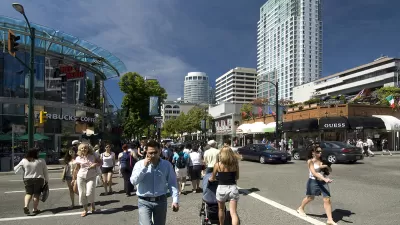Who should be required to take the first step in suburban retrofitting? The city, in the form of providing walkable, bikeable streets, or developers, by conforming to pedestrian-oriented building standards?
"A proposed Trader Joe's in Boulder, Colorado, brought up an interesting question this week in a spirited exchange on the Pro-Urb urban issues listserv: In auto-centric places where streets and infrastructure lack any sense of meaningful pedestrian amenity, who should take the lead on turning things around?"
"That is, should developers be required to build urban, pedestrian-oriented buildings fronting streets that are currently engineered as high speed arterials, in the hopes that, over time, a critical mass of new urban construction will foster the political will necessary to overhaul the infrastructure in further service of pedestrians and bicyclists? Or should the infrastructure be required to change first before any demands are placed on the private sector?"
Scott Doyon goes on to work through both sides of the debate, and asks readers to weigh in.
Thanks to Hazel Borys
FULL STORY: Chicken or the Egg: Who takes the lead on incremental suburban retrofitting?

Trump Administration Could Effectively End Housing Voucher Program
Federal officials are eyeing major cuts to the Section 8 program that helps millions of low-income households pay rent.

Planetizen Federal Action Tracker
A weekly monitor of how Trump’s orders and actions are impacting planners and planning in America.

The 120 Year Old Tiny Home Villages That Sheltered San Francisco’s Earthquake Refugees
More than a century ago, San Francisco mobilized to house thousands of residents displaced by the 1906 earthquake. Could their strategy offer a model for the present?

Alabama School Forestry Initiative Brings Trees to Schoolyards
Trees can improve physical and mental health for students and commnity members.

NYC Outdoor Dining Could Get a Re-Do
The city council is considering making the al fresco dining program year-round to address cost concerns from small businesses.

HSR Reaches Key Settlement in Northern California City
The state’s high-speed rail authority reached an agreement with Millbrae, a key city on the train’s proposed route to San Francisco.
Urban Design for Planners 1: Software Tools
This six-course series explores essential urban design concepts using open source software and equips planners with the tools they need to participate fully in the urban design process.
Planning for Universal Design
Learn the tools for implementing Universal Design in planning regulations.
Ada County Highway District
Clanton & Associates, Inc.
Jessamine County Fiscal Court
Institute for Housing and Urban Development Studies (IHS)
City of Grandview
Harvard GSD Executive Education
Toledo-Lucas County Plan Commissions
Salt Lake City
NYU Wagner Graduate School of Public Service




























